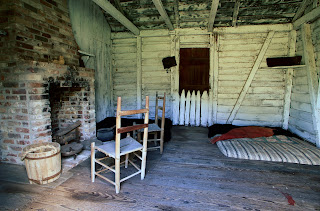 |
| Antebellum-style Plantation House |
Visions of Scarlett O’Hara’s Tara from the movie Gone with the Wind or the famous Oak Alley Plantation sweep through ones’ mind when conjuring up those antebellum period plantations of the deep south for some. However, for the black race and people of color, plantation life in the 1700s and 1800s was a constant struggle just to stay alive. In The Last Timekeepers and the Noble Slave, the third installment of The Last Timekeepers time travel adventure series, eleven-year-old protagonist Drake Bailey must confront not only his demons, but the terrible oppression and cruelty against his race in antebellum Georgia.
When I researched these grand Southern homes for my
novel, I found a few myths in this mired past. In movies, plantations were often
depicted as ‘mansions’ with fluted columns and a broad porch; massive trees
with their drooping limbs lining circular driveways, and finely dressed men and
women parading their wealth for all to see. Um, no. There were a few
plantations which fit this description, but these were the exceptions. Most
plantation owners lived modestly and some even poorly. The overwhelming
majority of slaveholders held less than twenty slaves. Yet, even if a man only
held one or two slaves, he had considerably more status in southern society
than a man who held no slaves. Status was everything to the South’s white
population, and the more slaves a man owned, the more respected he was.
The plantation was a world in itself. I created the
fictional Taylor Plantation situated
near Athens Georgia, close to where my time traveling characters would land. Trying
to keep the grounds as authentic as I could, the plantation was comprised of
the slave owner’s house (the Taylors) which was called the ‘big house’, the
line of single-room cabins dubbed ‘slave row’ where slaves called ‘home’, and nearby
loomed the overseer’s house. Scattered about this plantation were various barns
and sheds where animals, tools, and the harvested crops were stored.
Surrounding everything were cotton fields and woods, and situated in the back
of the property lurked the slave cemetery by a winding creek.
 |
| Interior of slave quarters |
would later become the United States of America, the crown offered large plots of land to settlers as an incentive for them to journey to a strange and harsh new world. Many settlers who took the deal combined their properties into larger settlements—in the South, these eventually became plantations. As these landowners needed immense manpower to maintain the plantations, they turned to slavery, importing captured peoples from Africa as forced laborers.
Plantations operated relatively unfettered in the
American South for more than 250 years; the Northern states, however, had all
abolished slavery by 1804. Despite Congress banning the African slave trade in
1808, the domestic slave trade in the South continued until the ratification of
the 13th Amendment in 1865, which banned slavery outright.
During Reconstruction (post-Civil War years), the
plantation system collapsed. While some plantations were destroyed, many were
subdivided, with both black and white farmers leasing these smaller plots as
sharecroppers (who would give a portion of their harvest to the landowner as
‘rent’) or tenant farmers (who paid rent). These farming practices continued
through the mid-20th century until the Great Depression and
advancements in farming technology got rid of traditional plantations for good.
Many people descended from African American slaves consider plantations to be the American version of Auschwitz. They’re not wrong. Filled with echoes of death and despair, Southern plantations—many of which are in disrepair and decay—are places where slavery made the romanticized southern lifestyle possible, and continue to carry their dark legacy to this day.
Here’s a snippet of what to expect in
the third installment of The Last Timekeepers available for purchase on all
your online bookstores…
True freedom happens only when you choose to be free.
Eleven-year-old Drake Bailey is an
analytical thinker and the genius of the Timekeeper crew. However, no logic or
mathematical acumen can change the color of his skin, or prepare him for this
third Timekeeper mission in antebellum Georgia. To survive, Drake must learn to
play the role of a plantation slave and when confronted with the brutality,
hatred, and racism of the deep south, he’ll have to strategically keep one move
ahead of his sadistic captors to ensure his lineage continues.
In a dark world of Voodoo, zombies, and ritualistic sacrifice, the Timekeepers must ensure a royal bloodline survives. Can Drake remove both literal and figurative chains to save both himself and a devout slave girl from a terrible fate? If he can’t summon the necessary courage, humanity could stand to lose one of its greatest leaders.

During one of my many trips to New Orleans, I visited the famous Oak Alley Plantation among others. One of my most enduring memories is how low the ceilings and doorways of the rooms were because the people back then were so short. This is an intriguing setting for a story. Congratulations on your wonderful book, Sharon.
ReplyDeleteThanks so much, Linda. Yes, we've gotten taller for some reason. Even new homes have 9' ceilings. History is so intriguing, that's for sure. Cheers!
DeleteI’ve visited a number of plantations. It’s interesting to see how they both differ and are yet similar. Good luck with your book.
ReplyDeleteThanks, Catherine. This research has sure opened my eyes. History can teach us all so much. Cheers and thanks for your support!
Delete